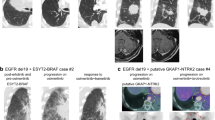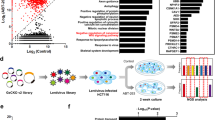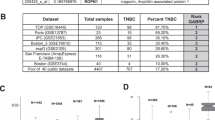Abstract
The gene encoding the receptor tyrosine kinase ERBB2, also known as HER2, is amplified and/or overexpressed in up to 15% of breast cancers. These tumours are characterised by an aggressive phenotype and poor clinical outcome. Although therapies targeted at ERBB2 have proven effective, many patients fail to respond to treatment or become resistant and the reasons for this are still largely unknown. Using a high-throughput functional screen we assessed whether genes found to be recurrently amplified and overexpressed in ERBB2+ve breast cancers mediate resistance to the ERBB2-targeted agent lapatinib. Lapatinib-resistant ERBB2-amplified breast cancer cell lines were screened, in the presence or absence of lapatinib, with an RNA interference library targeting 369 genes recurrently amplified and overexpressed in both ERBB2-amplified breast cancer tumours and cell lines. Small interfering RNAs targeting a number of genes caused sensitivity to lapatinib in this context. The mechanisms of resistance conferred by the identified genes were further investigated and in the case of NIBP (TRAPPC9), lapatinib resistance was found to be mediated through NF-κB signalling. Our results indicate that specific amplified and/ or overexpressed genes found in ERBB2-amplified breast cancer may mediate response to ERBB2-targeting agents.
This is a preview of subscription content, access via your institution
Access options
Subscribe to this journal
Receive 50 print issues and online access
$259.00 per year
only $5.18 per issue
Buy this article
- Purchase on Springer Link
- Instant access to full article PDF
Prices may be subject to local taxes which are calculated during checkout





Similar content being viewed by others
References
Reis-Filho JS, Pusztai L . Gene expression profiling in breast cancer: classification, prognostication, and prediction. Lancet 2011; 378: 1812–1823.
Curtis C, Shah SP, Chin SF, Turashvili G, Rueda OM, Dunning MJ et al. The genomic and transcriptomic architecture of 2000 breast tumours reveals novel subgroups. Nature 2012; 486: 346–352.
Alvarez RH, Valero V, Hortobagyi GN . Emerging targeted therapies for breast cancer. J Clin Oncol 2010; 28: 3366–3379.
Slamon DJ, Leyland-Jones B, Shak S, Fuchs H, Paton V, Bajamonde A et al. Use of chemotherapy plus a monoclonal antibody against HER2 for metastatic breast cancer that overexpresses HER2. N Engl J Med 2001; 344: 783–792.
Slamon DJ, Clark GM, Wong SG, Levin WJ, Ullrich A, McGuire WL . Human breast cancer: correlation of relapse and survival with amplification of the HER-2/neu oncogene. Science 1987; 235: 177–182.
Baehner FL, Achacoso N, Maddala T, Shak S, Quesenberry CP, Goldstein LC et al. Human epidermal growth factor receptor 2 assessment in a case-control study: comparison of fluorescence in situ hybridization and quantitative reverse transcription polymerase chain reaction performed by central laboratories. J Clin Oncol 2010; 28: 4300–4306.
Tse CH, Hwang HC, Goldstein LC, Kandalaft PL, Wiley JC, Kussick SJ et al. Determining true HER2 gene status in breast cancers with polysomy by using alternative chromosome 17 reference genes: implications for anti-HER2 targeted therapy. J Clin Oncol 2011; 29: 4168–4174.
Lal P, Salazar PA, Hudis CA, Ladanyi M, Chen B . HER-2 testing in breast cancer using immunohistochemical analysis and fluorescence in situ hybridization: a single-institution experience of 2279 cases and comparison of dual-color and single-color scoring. Am J Clin Pathol 2004; 121: 631–636.
Owens MA, Horten BC, Da Silva MM . HER2 amplification ratios by fluorescence in situ hybridization and correlation with immunohistochemistry in a cohort of 6556 breast cancer tissues. Clin Breast Cancer 2004; 5: 63–69.
Saini KS, Azim HA, Metzger-Filho O, Loi S, Sotiriou C, de Azambuja E et al. Beyond trastuzumab: new treatment options for HER2-positive breast cancer. Breast 2011; 20 (Suppl 3): S20–S27.
Graus-Porta D, Beerli RR, Daly JM, Hynes NE . ErbB-2, the preferred heterodimerization partner of all ErbB receptors, is a mediator of lateral signaling. EMBO J 1997; 16: 1647–1655.
Tzahar E, Waterman H, Chen X, Levkowitz G, Karunagaran D, Lavi S et al. A hierarchical network of interreceptor interactions determines signal transduction by Neu differentiation factor/neuregulin and epidermal growth factor. Mol Cell Biol 1996; 16: 5276–5287.
Graus-Porta D, Beerli RR, Hynes NE . Single-chain antibody-mediated intracellular retention of ErbB-2 impairs Neu differentiation factor and epidermal growth factor signaling. Mol Cell Biol 1995; 15: 1182–1191.
Spencer KS, Graus-Porta D, Leng J, Hynes NE, Klemke RL . ErbB2 is necessary for induction of carcinoma cell invasion by ErbB family receptor tyrosine kinases. J Cell Biol 2000; 148: 385–397.
Beerli RR, Graus-Porta D, Woods-Cook K, Chen X, Yarden Y, Hynes NE . Neu differentiation factor activation of ErbB-3 and ErbB-4 is cell specific and displays a differential requirement for ErbB-2. Mol Cell Biol 1995; 15: 6496–6505.
Geyer CE, Forster J, Lindquist D, Chan S, Romieu CG, Pienkowski T et al. Lapatinib plus capecitabine for HER2-positive advanced breast cancer. N Engl J Med 2006; 355: 2733–2743.
Xia W, Mullin RJ, Keith BR, Liu LH, Ma H, Rusnak DW et al. Anti-tumor activity of GW572016: a dual tyrosine kinase inhibitor blocks EGF activation of EGFR/erbB2 and downstream Erk1/2 and AKT pathways. Oncogene 2002; 21: 6255–6263.
Konecny GE, Pegram MD, Venkatesan N, Finn R, Yang G, Rahmeh M et al. Activity of the dual kinase inhibitor lapatinib (GW572016) against HER-2-overexpressing and trastuzumab-treated breast cancer cells. Cancer Res 2006; 66: 1630–1639.
Nagata Y, Lan KH, Zhou X, Tan M, Esteva FJ, Sahin AA et al. PTEN activation contributes to tumor inhibition by trastuzumab, and loss of PTEN predicts trastuzumab resistance in patients. Cancer Cell 2004; 6: 117–127.
Yakes FM, Chinratanalab W, Ritter CA, King W, Seelig S, Arteaga CL . Herceptin-induced inhibition of phosphatidylinositol-3 kinase and Akt Is required for antibody-mediated effects on p27, cyclin D1, and antitumor action. Cancer Res 2002; 62: 4132–4141.
Clynes RA, Towers TL, Presta LG, Ravetch JV . Inhibitory Fc receptors modulate in vivo cytoxicity against tumor targets. Nat Med 2000; 6: 443–446.
Park S, Jiang Z, Mortenson ED, Deng L, Radkevich-Brown O, Yang X et al. The therapeutic effect of anti-HER2/neu antibody depends on both innate and adaptive immunity. Cancer Cell 2010; 18: 160–170.
Vogel CL, Cobleigh MA, Tripathy D, Gutheil JC, Harris LN, Fehrenbacher L et al. Efficacy and safety of trastuzumab as a single agent in first-line treatment of HER2-overexpressing metastatic breast cancer. J Clin Oncol 2002; 20: 719–726.
Spector NL, Blackwell KL . Understanding the mechanisms behind trastuzumab therapy for human epidermal growth factor receptor 2-positive breast cancer. J Clin Oncol 2009; 27: 5838–5847.
Ritter CA, Perez-Torres M, Rinehart C, Guix M, Dugger T, Engelman JA et al. Human breast cancer cells selected for resistance to trastuzumab in vivo overexpress epidermal growth factor receptor and ErbB ligands and remain dependent on the ErbB receptor network. Clin Cancer Res 2007; 13: 4909–4919.
Junttila TT, Akita RW, Parsons K, Fields C, Lewis Phillips GD, Friedman LS et al. Ligand-independent HER2/HER3/PI3K complex is disrupted by trastuzumab and is effectively inhibited by the PI3K inhibitor GDC-0941. Cancer Cell 2009; 15: 429–440.
Lu Y, Zi X, Zhao Y, Mascarenhas D, Pollak M . Insulin-like growth factor-I receptor signaling and resistance to trastuzumab (Herceptin). J Natl Cancer Inst 2001; 93: 1852–1857.
Saal LH, Holm K, Maurer M, Memeo L, Su T, Wang X et al. PIK3CA mutations correlate with hormone receptors, node metastasis, and ERBB2, and are mutually exclusive with PTEN loss in human breast carcinoma. Cancer Res 2005; 65: 2554–2559.
Stemke-Hale K, Gonzalez-Angulo AM, Lluch A, Neve RM, Kuo WL, Davies M et al. An integrative genomic and proteomic analysis of PIK3CA, PTEN, and AKT mutations in breast cancer. Cancer Res 2008; 68: 6084–6091.
Berns K, Horlings HM, Hennessy BT, Madiredjo M, Hijmans EM, Beelen K et al. A functional genetic approach identifies the PI3K pathway as a major determinant of trastuzumab resistance in breast cancer. Cancer Cell 2007; 12: 395–402.
Eichhorn PJ, Gili M, Scaltriti M, Serra V, Guzman M, Nijkamp W et al. Phosphatidylinositol 3-kinase hyperactivation results in lapatinib resistance that is reversed by the mTOR/phosphatidylinositol 3-kinase inhibitor NVP-BEZ235. Cancer Res 2008; 68: 9221–9230.
Codony-Servat J, Albanell J, Lopez-Talavera JC, Arribas J, Baselga J . Cleavage of the HER2 ectodomain is a pervanadate-activable process that is inhibited by the tissue inhibitor of metalloproteases-1 in breast cancer cells. Cancer Res 1999; 59: 1196–1201.
Christianson TA, Doherty JK, Lin YJ, Ramsey EE, Holmes R, Keenan EJ et al. NH2-terminally truncated HER-2/neu protein: relationship with shedding of the extracellular domain and with prognostic factors in breast cancer. Cancer Res 1998; 58: 5123–5129.
Scaltriti M, Rojo F, Ocana A, Anido J, Guzman M, Cortes J et al. Expression of p95HER2, a truncated form of the HER2 receptor, and response to anti-HER2 therapies in breast cancer. J Natl Cancer Inst 2007; 99: 628–638.
Sperinde J, Jin X, Banerjee J, Penuel E, Saha A, Diedrich G et al. Quantitation of p95HER2 in paraffin sections by using a p95-specific antibody and correlation with outcome in a cohort of trastuzumab-treated breast cancer patients. Clin Cancer Res 2010; 16: 4226–4235.
Scaltriti M, Chandarlapaty S, Prudkin L, Aura C, Jimenez J, Angelini PD et al. Clinical benefit of lapatinib-based therapy in patients with human epidermal growth factor receptor 2-positive breast tumors coexpressing the truncated p95HER2 receptor. Clin Cancer Res 2010; 16: 2688–2695.
Chin K, DeVries S, Fridlyand J, Spellman PT, Roydasgupta R, Kuo WL et al. Genomic and transcriptional aberrations linked to breast cancer pathophysiologies. Cancer Cell 2006; 10: 529–541.
Marchio C, Natrajan R, Shiu KK, Lambros MB, Rodriguez-Pinilla SM, Tan DS et al. The genomic profile of HER2-amplified breast cancers: the influence of ER status. J Pathol 2008; 216: 399–407.
Staaf J, Jonsson G, Ringner M, Vallon-Christersson J, Grabau D, Arason A et al. High-resolution genomic and expression analyses of copy number alterations in HER2-amplified breast cancer. Breast Cancer Res 2010; 12: R25.
Shiu KK, Natrajan R, Geyer FC, Ashworth A, Reis-Filho JS . DNA amplifications in breast cancer: genotypic-phenotypic correlations. Future Oncol 2010; 6: 967–984.
Santarius T, Shipley J, Brewer D, Stratton MR, Cooper CS . A census of amplified and overexpressed human cancer genes. Nat Rev Cancer 2010; 10: 59–64.
Shiu KK, Wetterskog D, Mackay A, Natrajan R, Lambros M, Sims D et al. Integrative molecular and functional profiling of ERBB2-amplified breast cancers identifies new genetic dependencies. Oncogene 2013; 33: 619–631.
Brough R, Frankum JR, Sims D, Mackay A, Mendes-Pereira AM, Bajrami I et al. Functional viability profiles of breast cancer. Cancer Discov 2011; 1: 260–273.
Dokmanovic M, Hirsch DS, Shen Y, Wu WJ . Rac1 contributes to trastuzumab resistance of breast cancer cells: Rac1 as a potential therapeutic target for the treatment of trastuzumab-resistant breast cancer. Mol Cancer Ther 2009; 8: 1557–1569.
Tanner M, Hollmen M, Junttila TT, Kapanen AI, Tommola S, Soini Y et al. Amplification of HER-2 in gastric carcinoma: association with Topoisomerase IIalpha gene amplification, intestinal type, poor prognosis and sensitivity to trastuzumab. Ann Oncol 2005; 16: 273–278.
Bang YJ, Van Cutsem E, Feyereislova A, Chung HC, Shen L, Sawaki A et al. Trastuzumab in combination with chemotherapy versus chemotherapy alone for treatment of HER2-positive advanced gastric or gastro-oesophageal junction cancer (ToGA): a phase 3, open-label, randomised controlled trial. Lancet 2010; 376: 687–697.
Hu WH, Pendergast JS, Mo XM, Brambilla R, Bracchi-Ricard V, Li F et al. NIBP, a novel NIK and IKK(beta)-binding protein that enhances NF-(kappa)B activation. J Biol Chem 2005; 280: 29233–29241.
Campbell KJ, Perkins ND . Reprogramming RelA. Cell Cycle. 2004; 3: 869–872.
Harris LN, You F, Schnitt SJ, Witkiewicz A, Lu X, Sgroi D et al. Predictors of resistance to preoperative trastuzumab and vinorelbine for HER2-positive early breast cancer. Clin Cancer Res 2007; 13: 1198–1207.
Dave B, Migliaccio I, Gutierrez MC, Wu MF, Chamness GC, Wong H et al. Loss of phosphatase and tensin homolog or phosphoinositol-3 kinase activation and response to trastuzumab or lapatinib in human epidermal growth factor receptor 2-overexpressing locally advanced breast cancers. J Clin Oncol 2010; 29: 166–173.
Scaltriti M, Eichhorn PJ, Cortes J, Prudkin L, Aura C, Jimenez J et al. Cyclin E amplification/overexpression is a mechanism of trastuzumab resistance in HER2+ breast cancer patients. Proc Natl Acad Sci USA 2011; 108: 3761–3766.
Sacher M, Barrowman J, Wang W, Horecka J, Zhang Y, Pypaert M et al. TRAPP I implicated in the specificity of tethering in ER-to-Golgi transport. Mol Cell 2001; 7: 433–442.
Galang CK, Garcia-Ramirez J, Solski PA, Westwick JK, Der CJ, Neznanov NN et al. Oncogenic Neu/ErbB-2 increases ets, AP-1, and NF-kappaB-dependent gene expression, and inhibiting ets activation blocks Neu-mediated cellular transformation. J Biol Chem 1996; 271: 7992–7998.
Merkhofer EC, Cogswell P, Baldwin AS . Her2 activates NF-kappaB and induces invasion through the canonical pathway involving IKKalpha. Oncogene 2010; 29: 1238–1248.
Xia W, Bacus S, Husain I, Liu L, Zhao S, Liu Z et al. Resistance to ErbB2 tyrosine kinase inhibitors in breast cancer is mediated by calcium-dependent activation of RelA. Mol Cancer Ther 2010; 9: 292–299.
Acknowledgements
We thank Breakthrough Breast Cancer and AACR SU2C for funding this work. We acknowledge NHS funding to the NIHR RMH Biomedical research Centre. We thank Dr David Watkins from the Royal Marsden hospital for the kind donation of the CR-OE33 cell line.
Author information
Authors and Affiliations
Corresponding authors
Ethics declarations
Competing interests
The authors declare no conflict of interest.
Additional information
Supplementary Information accompanies the paper on the Oncogene website
Supplementary information
Rights and permissions
About this article
Cite this article
Wetterskog, D., Shiu, KK., Chong, I. et al. Identification of novel determinants of resistance to lapatinib in ERBB2-amplified cancers. Oncogene 33, 966–976 (2014). https://doi.org/10.1038/onc.2013.41
Received:
Revised:
Accepted:
Published:
Issue Date:
DOI: https://doi.org/10.1038/onc.2013.41
Keywords
This article is cited by
-
Functional signaling test identifies HER2 negative breast cancer patients who may benefit from c-Met and pan-HER combination therapy
Cell Communication and Signaling (2022)
-
Rac inhibition as a novel therapeutic strategy for EGFR/HER2 targeted therapy resistant breast cancer
BMC Cancer (2021)
-
HER3 PET Imaging Identifies Dynamic Changes in HER3 in Response to HER2 Inhibition with Lapatinib
Molecular Imaging and Biology (2021)
-
The Evolving Landscape of HER2-Directed Breast Cancer Therapy
Current Treatment Options in Oncology (2020)
-
Synergistic effects of various Her inhibitors in combination with IGF-1R, C-MET and Src targeting agents in breast cancer cell lines
Scientific Reports (2017)



